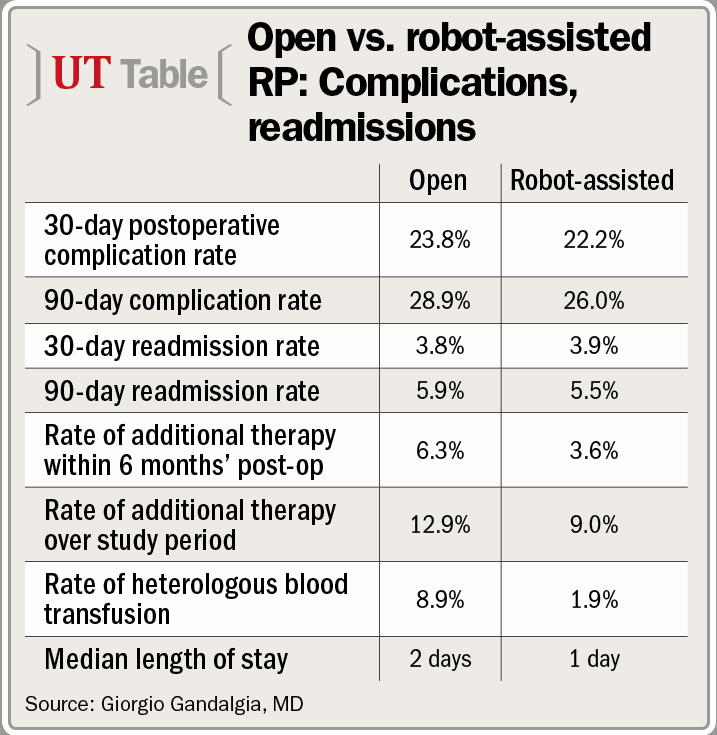Article
RARP: ‘Little clear benefit’ compared to open surgery
Robot-assisted radical prostatectomy is associated with a lower rate of blood transfusion and shorter length of stay compared to open surgery. However, the total first-year reimbursement is higher for RARP and there is no difference between the two procedures in the rate of postoperative complications or use of additional cancer treatment, according to an analysis of contemporary data from the Surveillance, Epidemiology, and End Results Medicare-linked database.
Montreal-Robot-assisted radical prostatectomy (RARP) is associated with a lower rate of blood transfusion and shorter length of stay compared to open surgery. However, the total first-year reimbursement is higher for RARP and there is no difference between the two procedures in the rate of postoperative complications or use of additional cancer treatment, according to an analysis of contemporary data from the Surveillance, Epidemiology, and End Results Medicare-linked database.
RELATED: Use of robotic RN rising, despite unclear advantages
The study was presented at the AUA annual meeting in Orlando, FL and was recently published in the Journal of Clinical Oncology (2014; 32:1419-26). It included 5,915 men operated on between October 2008 and December 2009, of whom 41% underwent open radical prostatectomy and 59% had RARP.
“RARP was rapidly adopted after its introduction and is currently the dominant technique for surgical treatment of localized prostate cancer in the U.S., accounting for more than 60% of radical prostatectomy procedures,” said first author Giorgio Gandaglia, MD, clinical research fellow, University of Montreal Health Center, Cancer Prognostics and Health Outcomes Unit, Montreal.
“Although reports from single-institution series show better outcomes with RARP than with an open approach, our study offers a population-based analysis of outcomes at the community level. It confirms previous investigations showing RARP is associated with substantially higher costs, but the main message is that RARP appears to have little clear benefit compared to open surgery. Nevertheless, although our study was designed to limit any effect of the steep learning curve for the robotic technique, we cannot rule out that RARP will prove to have greater benefit at a later time post-adoption.”
The men in both study groups had a mean age of about 69 years and were predominantly Caucasian (~82%). Compared to the open surgery group, men undergoing RARP had significantly worse disease features according to analyses of clinical stage and Gleason score, but the open group had higher proportions of men with preoperative PSA >10.0 ng/mL and categorized as having high-risk disease. There were also statistically significant differences between surgical groups in pelvic lymph node dissection status and nodal stage such that patients treated with the minimally invasive approach were less likely to receive a PLND and to have nodal involvement.
Next: No significant differences in complications

No significant differences in complications
Comparisons between the open and RARP groups showed no significant differences in the 30-day or 90-day postoperative complication rates (23.8% vs. 22.2% and 28.9% vs. 26.0%) nor in the 30-day or 90-day readmission rates (3.8% vs. 3.9% and 5.9% vs. 5.5%). Within the first 6 months after surgery, 6.3% of men who underwent open surgery and 3.6% of men in the RARP group received additional cancer therapy with radiotherapy or androgen deprivation, and over the entire study period, the rates of additional cancer therapy in the open and RARP groups rose to 12.9% and 9.0%, respectively (p<.001 for both comparisons). Rates of heterologous blood transfusion were 8.9% in the open group and 1.9% in men having RARP, and median length of stay in the two groups was 2 days and 1 day, respectively (p<.001 for both comparisons).
In determining the relative odds of the outcome measures of interest, an instrumental variable analysis technique was used that limited possible biases related to the effect of confounding factors. Its results showed statistically significant differences between the two techniques persisted in first-year reimbursement and risks of having a heterologous blood transfusion and prolonged length of stay, but not in risk of needing additional cancer therapy.
You might also like:
Anti-PCa screening message unlikely to make waves
Robotic radical nephrectomy: There is a rationale
Number of sexual partners linked to PCa risk
Subscribe to Urology Times to get monthly news from the leading news source for urologists.
Newsletter
Stay current with the latest urology news and practice-changing insights — sign up now for the essential updates every urologist needs.













